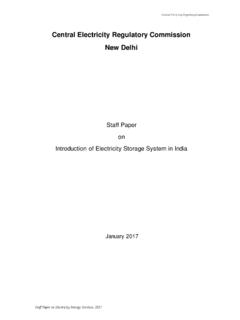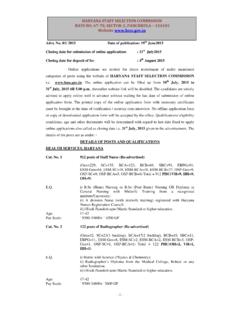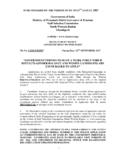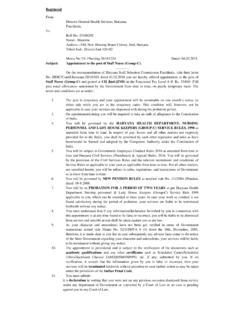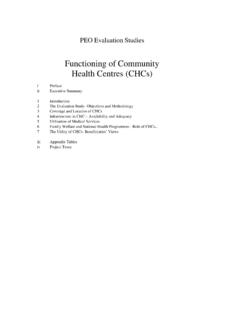Transcription of THE ELECTRICITY REGULATORY COMMISSIONS …
1 THE ELECTRICITY REGULATORY COMMISSIONS ACT, 1998 (No. 14 of 1998 ) CHAPTER I PRELIMINARY 1. Short title, extent and commencement. 2. Definitions. CHAPTER II CENTRAL ELECTRICITY REGULATORY commission 3. Establishment and incorporation of Central commission 4. Qualification for appointment of Chairperson and other Members of the Central commission . 5. Constitution of Selection Committee to recommend Members 6. Term of office, salary and allowances and other conditions of service of Chairperson and Members 7. Removal of Members 8. Officers of the Central commission and other staff 9. Proceedings of the Central commission 10. Vacancies, etc., not to invalidate the proceedings of the Central commission 11.
2 Expenses of Central commission to be charged upon Consolidated-Fund of India 12. Powers of the Central commission CHAPTER III POWERS AND FUNCTIONS OF THE CENTRAL commission 13. Functions of the Central commission 14. The Central Advisory Committee 15. The Object of the Central Advisory Committee 16. Appeal to High Court in certain cases CHAPTER IV STATE ELECTRICITY REGULATORY commission 17. Establishment and incorporation of State commission 18. Constitution of Selection Committee by the State Government. 19. Term of office, salary and allowances and other conditions of service of Chairperson and Members 20. Removal of Members 21. Officers of the State commission and other staff CHAPTER V POWERS AND FUNCTIONS OF THE STATE commission 22.
3 Functions of State commission 23. Application of certain provisions relating to Central commission to State COMMISSIONS 24. The State Advisory Committee 25. Objects of the State Advisory Committee 26. Representation before State commission 27. Appeal to High Court in certain cases CHAPTER VI ENERGY TARIFF 28. Determination of tariff by Central commission 29. Determination of tariff by State commission 30. Reasons for deviation by the COMMISSIONS CHAPTER VII ACCOUNTS, AUDIT AND REPORTS 31. Budget of the Central commission 32. Accounts and audit of Central commission 33. Budget of the State commission 34. Accounts and audit of State commission 35. Annual report of Central commission 36. Annual report of State commission CHAPTER VIII MISCELLANEOUS 37.
4 Transparency in COMMISSIONS 38. Directions by Central Government 39. Directions by State Government 40. Members, officers and employees of Central commission to be public servants 41. Special provision relating to the Orissa ElectricityReform Act, 1995 or Haryana State ELECTRICITY Reform Act, 1997 42. Proceedings before the commission 43. Protection of action taken in good faith 44. Punishment for non-compliance of orders or directions under the Act 45. Punishment for non-compliance of directions given by a commission 46. Power of seizure 47. Offence by companies 48. Cognizance of offences 49. Inconsistency in laws 50. Delegation 51. Amendment of Act 54 of 1948 52.
5 Overriding effect 53. Power to give directions 54. Power of Central Government to make rules 55. Power of Central commission to make regulations 56. Rules and regulations to be laid before Parliament 57. Power of State Government to make rules 58. Power of State commission to make regulations 59. Rules and regulations to be laid before State Legislature 60. Power to remove difficulties 61. Repeal and Saving THE ELECTRICITY REGULATORY COMMISSIONS ACT, 1998 (No. 14 of 1998 )1 [2nd July 1998 ] 1. PUBLISHED IN THE GAZETTE OF INDIA, EXTRAORDINARY, PART II, SEC. 1 DATED 2ND JULY, 1998 ( 25TH APRIL, 1998 ). An Act to provide for the establishment of a Central ELECTRICITY REGULATORY commission and State ELECTRICITY REGULATORY COMMISSIONS , rationalization of ELECTRICITY tariff, transparent policies regarding subsidies, promotion of efficient and environmentally benign policies and matters connected therewith or incidental thereto.
6 Be it enacted by Parliament in the Forty-ninth Year of the republic of India as follows: STATEMENT OF OBJECTS AND REASONS India's power sector is beset by problems that impede its capacity to respond to the rapidly growing demand for energy brought about by economic liberalisation. Despite the stated desire for reform and the initial measures that have been implemented, serious problems persist. As the problems of the Power Sector deepen, reform becomes increasingly difficult underscoring the need to act decisively and without delay. It is essential that the Government exit implement significant reforms by focussing on the fundamental issues facing the power sector, namely the lack of rational retail tariffs, the high level of cross-subsidies, poor planning and operation, inadequate capacity, the neglect of the consumer, the limited involvement of private sector skills and resources and the absence of an independent REGULATORY authority, Considering the paramount importance of restructure power sector, Government of India organised two Conferences of Chie Ministers to discuss the whole gamut of issues in the power sector and the outcome of these meetings was the adoption of the Common Minimum National Action Plan for Power (CMNPP).
7 2. The CMNPP recognised that the gap between demand and supply of power is widening and acknowledged that the financial position of State ELECTRICITY Boards is fast deteriorating and the future development in the power sector cannot be sustained without viable State ELECTRICITY Boards and improvement of their operational performance. The CMNPP identified creation of REGULATORY commission as a step in this direction and specifically provided for establishment of the Central ELECTRICITY REGULATORY commission (CERC) and State ELECTRICITY REGULATORY COMMISSIONS (SERCs). After the finalisation of the, national agenda contained in CMNPP, the Ministry of Power assigned the task of studying the restructuring needs of the REGULATORY system to Administrative Staff College of India (ASCI), Hyderabad.
8 The ASCI report strongly recommended the creation of independent ELECTRICITY REGULATORY COMMISSIONS both at the Centre and the States. 3. To give effect to the aforesaid proposals, the ELECTRICITY REGULATORY COMMISSIONS Bill. 1997 was introduced in the Lok Sabha on 14th August, 1997, However it could not be passed due to the dissolution of the Eleventh Lok Sabha. This has resulted in delay in establishing the REGULATORY COMMISSIONS leading to confusion and misgivings in various sections about the commitment of the Government to the reforms and restructuring of the power sector. Needless to say, this has also slowed down the flow of public and private investment in power sector.
9 Since it was considered necessary to ensure the speedy establishment of the REGULATORY COMMISSIONS and as Parliament was not in session, the President promulgated the ELECTRICITY REGULATORY COMMISSIONS Ordinance, 1998 on 25th day of April, 1998 . 4. The salient features of the -said Ordinance are as follows: - (a) It provides for the establishment of a Central ELECTRICITY REGULATORY commission at the Central level and State ELECTRICITY COMMISSIONS at the State levels-, (b) The main functions of CERC are: - (i) To regulate the tariff of generating companies owned or controlled by the Central Government; (ii) To regulate inter-State transmission including tariff of the transmission utilities; (iii) To regulate inter-State sale of power; (iv) To aid and advise the Central Government in the formulation of tariff policy.
10 (c) The main functions of the SERC, to start with, shall be: - (i) To determine the tariff for ELECTRICITY , wholesale, bulk, grid and retail; (ii) To determine the tariff payable for use of the transmission facilities; (iii) To regulate power purchase the procurement process of the transmission utilities; and (iv) Subsequently, as and when each State Government notifies, other REGULATORY functions could also be assigned to SERCS. (d) It also aims at improving the financial health of the State ELECTRICITY Boards (SEBS) which are loosing heavily on account of irrational tariffs and lack of budgetary support from the State Governments as a result of which, the SEBs have become incapable of even proper maintenance, leave alone purposive investment.
